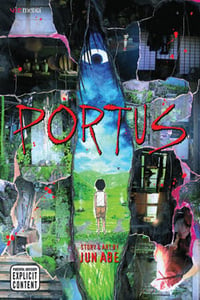Review
by Carl Kimlinger,Portus
GN
| Synopsis: |  |
||
Everyone who really gets into a video game complains about it sucking their life away, but few people are actually killed by them. Portus is a game that kills people. Or more accurately, forces them to kill themselves. Hanging, exsanguinating—too many people have died in too weird of ways for it to be mere coincidence. When young Asami's best friend dies under those same circumstances, she and two of her teachers investigate, entangling themselves in a supernatural tale well beyond their control; a tale of a game, a cursed doll, a rural madman, and a village with some very bloody skeletons in its closet. It's all tied somehow to Takashi, a monstrous boy who has made Portus into his own twisted little playground, welcoming the unwary into a hell of insanity and pain. And his eyes are on Asami |
|||
| Review: | |||
Mashing together horror tropes at the crossroads of technology and superstition popularized by the current wave of Japanese horror films, Portus is an enthusiastic but empty attempt to do for video games what The Ring did for mysterious blank videotapes. Unfortunately it's about eight years and a hundred movies too late. Rule number one of horror is be scary. Much can be forgiven of a truly scary story—more stupidity has been suffered for the sake of a single moment of abject terror than perhaps any reaction in the history of entertainment. Unfortunately, Portus' author Jun Abe is under the mistaken impression that gleaning elements from other horror sources is the best way to get to those moments. On top of exploiting the same technology/superstition niche as countless other Japanese horror efforts, Abe lifts his central premise—a technology cursed by the soul of a tragic child—straight from The Ring and mines nearly every corner of the horror genre for elements with which to dress it. Creepy children, urban legends, rampaging madmen, cursed dolls, corporeal phantoms, tragedies that haunt the present, even urbanite ideas about the depravity that lurks under tranquil rural exteriors (thank you Deliverance)—Abe crams so many of them in that before long the book is more silly than scary. This wouldn't be nearly the sticking point that it is were Abe able to synthesize his disparate inspirations convincingly or at least coax a killer climax out of them, but they're all jumbled together willy-nilly and the climactic "pop-psychology saves the day" scene would be hilarious if it weren't so dispiritingly lazy. Also, that "ha, gotcha!" on the last page should have been left to rot in the cesspool of bad eighties slasher flicks that it came from. The book's few isolated sublimely creepy sequences owe their existence entirely to the fact that Abe's skill as an illustrator far outstrips his skill as a writer. Carefully textured and almost insanely detailed, his art is at times really, truly freaky, especially his habit of delving into hyper-realism during the book's most disturbing moments. His world of lurking shadows and fleshy horrors is suitably nasty, and Takashi's dream-worlds are impressive visual inventions (especially one in which a giant butterfly is torn to pieces by a room full of flesh-eating worms). His love of skewed angles and disturbing imagery often gets the better of him though. Facial expressions, though meticulously drawn, are so extreme and so skewed that scenes intended to be intense become merely over-ripe—Takashi in particular is more cheesy than scary, always grimacing, gritting his teeth and stretching his face this way and that. And squeamish readers beware, the book earns its mature rating with a pair of graphic rape scenes (at least one of which is entirely gratuitous) and more lovingly-rendered dismemberments than anyone would care to count. Viz presents this one-shot with essentially the same quality that they do all their other titles. The artwork is clear, the sound effects replaced, and the extras nil. Sound effects aren't as much a part of the artwork as in other titles, so the English replacements aren't intrusive, and really, what would the cultural notes say? If you aren't the type to know beforehand where nearly every scene that was ripped off was ripped from, then this book wasn't aimed at you in the first place. All of Jun Abe's technical skill as an illustrator and obvious enthusiasm for horror (you don't collect this many clichés without having seen a lot of horror) can't prevent Asami's pouty tantrums in the opening chapter from being the book's most memorable moments. If you want to have the bejeezus scared out of you, read something really scary, like Monster. However, if all you're looking for is the odd shiver while being constantly grossed out, then Portus is your book. |
| Grade: | |||
|
Overall : C
Story : C-
Art : B
+ Freaky art. |
|||
| discuss this in the forum (5 posts) | | |||
| Production Info: | ||
|
Full encyclopedia details about Release information about |
||